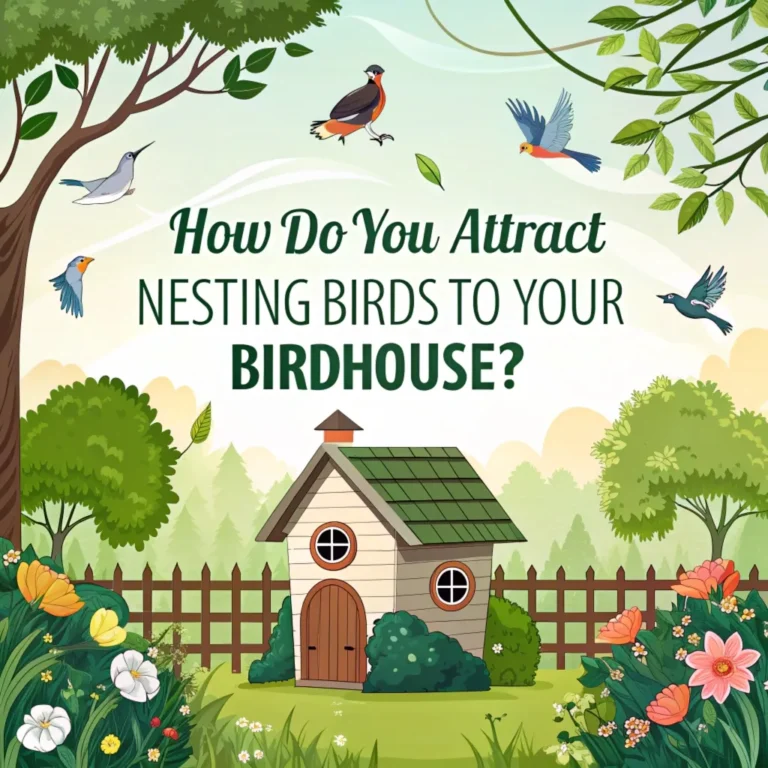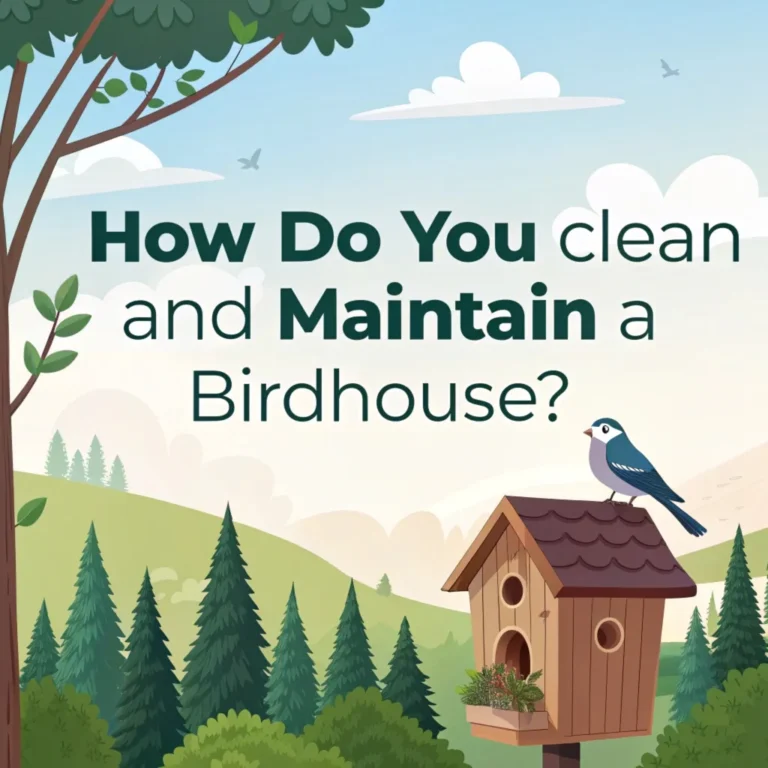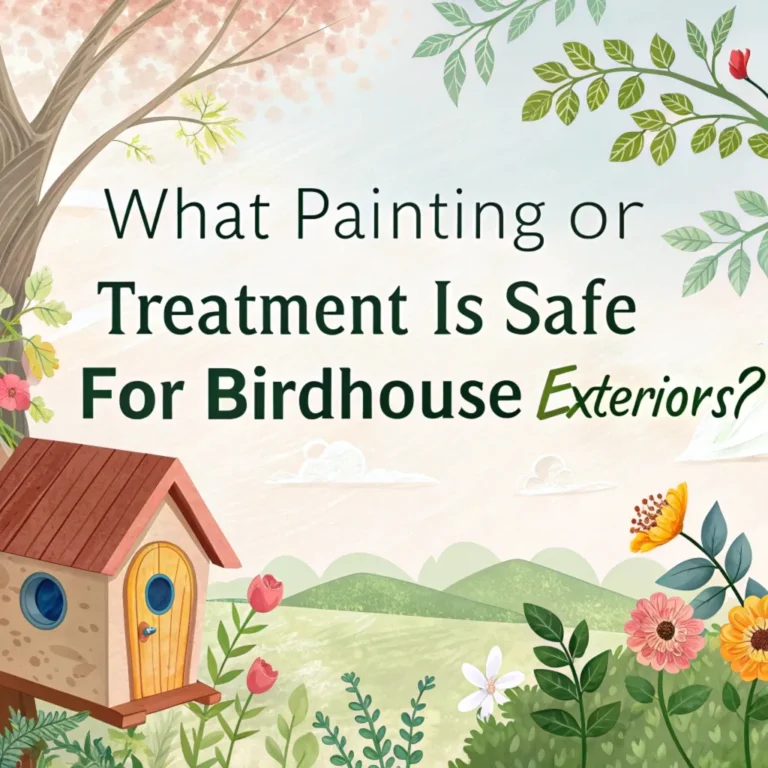How to Prevent Predators From Accessing Birdhouses? Expert Advice and Solutions
Birds need safe places to nest and raise their young. Birdhouses provide this shelter, but they can also attract unwanted visitors. Predators pose a serious threat to nesting birds.
This guide offers practical methods to keep birdhouses secure. By following these steps, you can create a safer environment for birds in your yard.
Learn how to design, place, and maintain birdhouses to deter predators effectively. These techniques will help ensure the success of nesting birds and increase bird populations in your area.

Key Takeaways
- Mount birdhouses on smooth poles with predator guards
- Remove perches from birdhouses to deter climbing predators
- Install proper-sized entrance holes to prevent larger predators
- Use predator guards such as baffles, Noel guards, and cone-shaped barriers
- Position birdhouses away from structures predators can jump from
- Clean birdhouses regularly to discourage pests
- Choose appropriate materials for birdhouse construction
- Implement proper drainage and ventilation in birdhouse design
- Consider location when placing birdhouses to minimize predator access
- Monitor and maintain birdhouses regularly for optimal protection
Creating a safe haven for birds in your backyard involves more than just hanging a birdhouse. It requires thoughtful planning and strategic implementation of various protective measures.
By understanding the behavior of common predators and the needs of nesting birds, you can create an environment that promotes successful breeding and increases bird populations in your area.
Predator prevention is an ongoing process that requires vigilance and adaptability. As you observe the interactions between birds and potential threats in your yard, you may need to adjust your strategies over time.
Remember that different bird species have unique nesting requirements, so it’s essential to tailor your approach to the specific birds you want to attract and protect.
Proper Birdhouse Design
The first line of defense against predators starts with the birdhouse design. Construct birdhouses using untreated wood, such as cedar, pine, or fir. These materials provide natural insulation and are safe for birds.
Ensure proper sizing of the entrance hole. The hole should be large enough for the intended bird species but small enough to keep out larger predators. For most songbirds, a 1.5-inch diameter hole works well.
Avoid adding perches to birdhouses. Birds don’t need them, and perches provide easy access for predators.
Proper birdhouse design goes beyond just the basics of construction. Consider the internal dimensions of the birdhouse to ensure it provides adequate space for nesting birds. Different species require varying floor space and cavity depths.
For example, bluebirds prefer a floor area of about 4×4 inches, while wood ducks need a much larger space of about 10×10 inches.
Ventilation is another crucial aspect of birdhouse design. Include small holes near the top of the sides or front of the birdhouse to allow for air circulation.
This helps regulate temperature inside the nest, preventing overheating during hot summer days. Additionally, slightly angle the roof to shed rainwater effectively, keeping the interior dry and comfortable for the nesting birds.
Strategic Placement

Mount birdhouses on smooth, slippery poles. Galvanized pipes or PVC pipes work well as they are difficult for predators to climb.
Position birdhouses at least 10 feet from the ground and 10 feet away from structures that predators could jump from.
Ensure proper spacing between the birdhouse and nearby vegetation. Leave 5 to 8 feet of open space to prevent predator ambushes while still allowing birds to scout the area.
Strategic placement of birdhouses involves more than just considering predator access. Take into account the preferred habitats of the bird species you’re trying to attract.
Some birds, like chickadees and titmice, prefer wooded areas, while others, such as bluebirds, favor open fields. Research the specific needs of your target species to provide the most suitable location for their nesting success.
Consider the direction the birdhouse entrance faces when placing it. In most regions, it’s best to orient the entrance away from prevailing winds and direct afternoon sun. This helps protect nestlings from harsh weather conditions and extreme temperatures.
Additionally, observe the activity in your yard to identify areas with high bird traffic, as these locations may be more attractive to nesting birds.
Effective Predator Guards
Install predator guards or baffles on the pole supporting the birdhouse. These devices prevent climbing predators from reaching the nest.
Cone-shaped baffles work well for pole-mounted birdhouses. These metal collars, about 3 feet in diameter, surround the pole beneath the birdhouse.
Stovepipe baffles, typically 8 inches in diameter and 24-36 inches long, offer excellent protection against climbing predators.
Noel guards, wire mesh tubes attached to the front of the birdhouse, provide additional protection. Use these in combination with other guards or on tree-mounted birdhouses.
Effective predator guards are essential for ensuring the safety of nesting birds, but their effectiveness can be enhanced by proper installation. When installing baffles or guards, ensure they are securely attached and positioned at the correct height.
For pole-mounted birdhouses, place the baffle at least 4 feet above the ground to prevent predators from jumping over it. Regularly inspect these guards for any signs of wear or damage, and replace them as needed.
Consider using multiple types of predator guards in combination for maximum protection. For example, you might use a stovepipe baffle on the mounting pole along with a Noel guard on the birdhouse entrance.
This multi-layered approach provides defense against both climbing predators and those that might try to reach into the nest. Remember to adapt your strategies based on the specific predators in your area and the behaviors you observe.
Additional Protection Measures

Extend the roof of the birdhouse at least 5 inches beyond the front. This design prevents predators from reaching into the entrance hole from above.
Install a predator block or guard on the front of the birdhouse. This extra piece of wood with a hole drilled in its center doubles the depth of the entrance, making it harder for predators to reach inside.
Use metal plates to reinforce the entrance hole. This prevents squirrels from chewing and enlarging the opening.
Additional protection measures can significantly enhance the safety of your birdhouses. Consider installing motion-activated lights or sprinklers near your birdhouses.
These devices can startle and deter nocturnal predators like raccoons or opossums. While these methods may not be suitable for all situations, they can be effective deterrents in areas with persistent predator problems.
Another innovative approach is to create decoy nests near your actual birdhouses. These can be simple structures that mimic the appearance of active nests but are designed to be less appealing or accessible to predators.
This strategy can divert predator attention away from occupied nests, giving nesting birds a better chance of success. Remember to monitor these decoys regularly and adjust their placement as needed to maintain their effectiveness.
Maintenance and Monitoring
Clean birdhouses regularly to discourage pests. Remove old nesting material and rinse with a solution of one part bleach to nine parts water.
Inspect birdhouses frequently for signs of predator activity, such as claw marks or disturbed nesting material.
Plug birdhouse entrances during winter to prevent house sparrows from claiming the space early in the season.
Maintenance and monitoring of birdhouses is a year-round responsibility that goes beyond just cleaning and inspection. Keep detailed records of nesting activity, including the species using each birdhouse, the dates of occupation, and the success rate of fledglings.
This information can help you identify patterns and make informed decisions about future birdhouse placement and protection strategies.
Consider using technology to aid in your monitoring efforts. Trail cameras or nest box cameras can provide valuable insights into bird behavior and potential predator activity without disturbing the nesting process.
These tools can help you identify specific threats and adjust your protection measures accordingly. Remember to respect wildlife laws and obtain any necessary permits before installing monitoring equipment.
Weather Protection
Ensure proper drainage by adding holes to the birdhouse floor or recessing the floor slightly.
Include ventilation holes near the top of the birdhouse to regulate temperature.
Choose a location that provides partial shade and protection from direct sunlight and rain.
Weather protection for birdhouses extends beyond basic design features. Consider the microclimate of your yard when placing birdhouses.
Areas with natural windbreaks, such as dense shrubs or trees, can provide additional protection from strong winds and storms. However, ensure these features don’t compromise predator protection measures.
In regions with extreme temperatures, you might need to take extra steps to protect nesting birds. For hot climates, consider adding reflective materials to the roof of the birdhouse to reduce heat absorption.
In colder areas, providing insulation within the walls of the birdhouse can help maintain a stable internal temperature. Always balance these modifications with the need for proper ventilation to ensure a healthy nesting environment.
Deterring Specific Predators
For raccoons, apply a thick layer of automotive or marine grease to the mounting pole in spring.
To deter cats, keep pet cats indoors during nesting season and avoid feeding feral cats in the area.
For snakes, wrap plastic sheeting around tree trunks or utility poles where birdhouses are mounted.
Deterring specific predators often requires a tailored approach based on the unique challenges in your area.
For areas with persistent squirrel problems, consider using squirrel baffles specifically designed to prevent these agile climbers from reaching birdhouses. These baffles are typically larger and more robust than standard predator guards.
In regions where hawks or other aerial predators pose a threat, creating cover near birdhouses can provide protection.
Plant dense shrubs or install brush piles within a short flight distance of the birdhouse. This gives smaller birds a quick escape route and shelter from aerial attacks. However, ensure these features don’t inadvertently create hiding spots for ground-based predators.
FAQs
What is the best material for building a birdhouse?
Untreated wood, such as cedar, pine, or cypress, is ideal for birdhouse construction. These materials provide natural insulation and are safe for birds.
How high should I mount my birdhouse?
Mount birdhouses at least 10 feet from the ground to keep them out of reach of many ground-based predators.
Are perches necessary on birdhouses?
No, perches are not necessary and can actually provide easy access for predators. It’s best to remove perches from birdhouses.
How often should I clean my birdhouse?
Clean birdhouses seasonally or when birds vacate their home. Use a solution of one part bleach to nine parts water for cleaning.
Can I paint my birdhouse?
If you choose to paint your birdhouse, use only environmentally safe paints on the exterior. Avoid painting the interior or the entrance hole’s inner rim.
By implementing these strategies, you can significantly reduce the risk of predators accessing your birdhouses. This protection ensures a safe environment for nesting birds, allowing you to enjoy their presence in your backyard.

Luna is the passionate founder and author of Birds and You, a website dedicated to sharing her love for birds with fellow enthusiasts. Through her engaging articles and guides, she aims to educate and inspire others to explore the fascinating world of birds. When she’s not writing, you can find Luna observing birds in their natural habitats or sharing beautiful bird photography on Pinterest. Join her on this journey to celebrate and protect our feathered friends!







